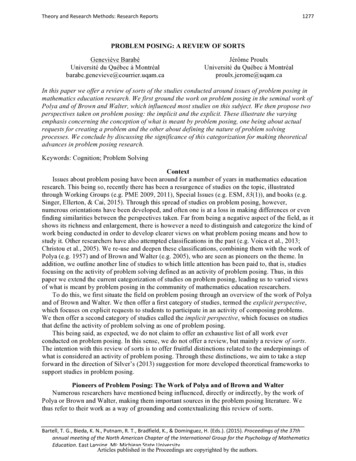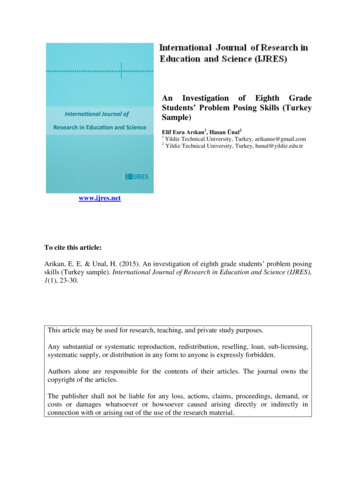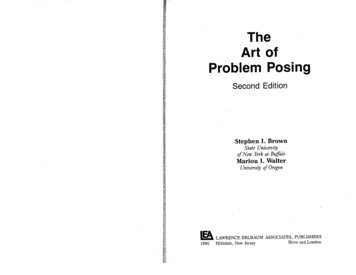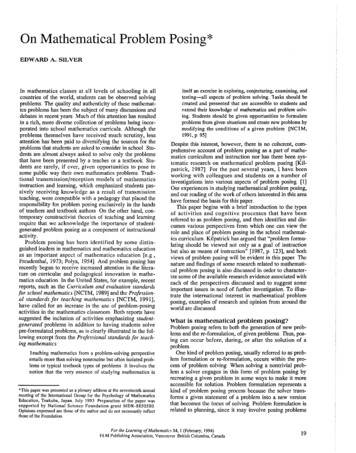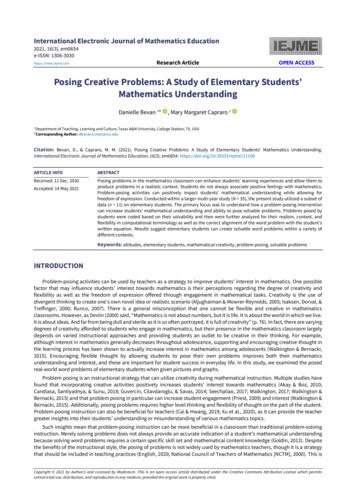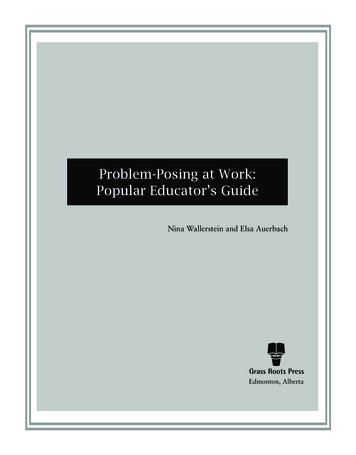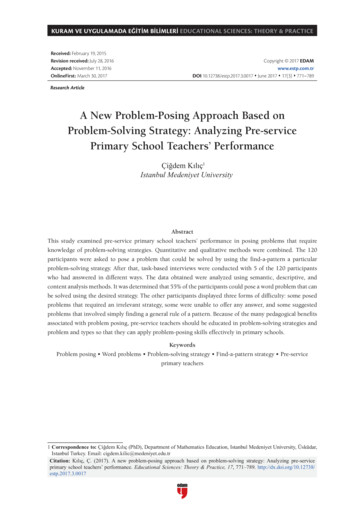
Transcription
KURAM VE UYGULAMADA EĞİTİM BİLİMLERİ EDUCATIONAL SCIENCES: THEORY & PRACTICEReceived: February 19, 2015Revision received: July 28, 2016Accepted: November 11, 2016OnlineFirst: March 30, 2017Copyright 2017 EDAMwww.estp.com.trDOI 10.12738/estp.2017.3.0017 June 2017 17(3) 771–789Research ArticleA New Problem-Posing Approach Based onProblem-Solving Strategy: Analyzing Pre-servicePrimary School Teachers’ PerformanceÇiğdem Kılıç1Istanbul Medeniyet UniversityAbstractThis study examined pre-service primary school teachers’ performance in posing problems that requireknowledge of problem-solving strategies. Quantitative and qualitative methods were combined. The 120participants were asked to pose a problem that could be solved by using the find-a-pattern a particularproblem-solving strategy. After that, task-based interviews were conducted with 5 of the 120 participantswho had answered in different ways. The data obtained were analyzed using semantic, descriptive, andcontent analysis methods. It was determined that 55% of the participants could pose a word problem that canbe solved using the desired strategy. The other participants displayed three forms of difficulty: some posedproblems that required an irrelevant strategy, some were unable to offer any answer, and some suggestedproblems that involved simply finding a general rule of a pattern. Because of the many pedagogical benefitsassociated with problem posing, pre-service teachers should be educated in problem-solving strategies andproblem and types so that they can apply problem-posing skills effectively in primary schools.KeywordsProblem posing Word problems Problem-solving strategy Find-a-pattern strategy Pre-serviceprimary teachers1 Correspondence to: Çiğdem Kılıç (PhD), Department of Mathematics Education, Istanbul Medeniyet University, Üsküdar,Istanbul Turkey. Email: cigdem.kilic@medeniyet.edu.trCitation: Kılıç, Ç. (2017). A new problem-posing approach based on problem-solving strategy: Analyzing pre-serviceprimary school teachers’ performance. Educational Sciences: Theory & Practice, 17, 771–789. http://dx.doi.org/10.12738/estp.2017.3.0017
EDUCATIONAL SCIENCES: THEORY & PRACTICEProblem posing has been described as the creation of new problems or thereformulation of a given problem (Tichá & Hošpesová, 2009) in order to exploreand solve a given situation (Silver 1994). Stoyanova and Ellerton (1996, p.518) similarly defined problem posing as “the process by which, on the basis ofmathematical experience, students construct personal interpretations of concretesituations and formulate them as meaningful mathematical problems.” According toChristou, Mousoulides, Pittalis, Pitta-Pantazi, and Sriraman (2005, p. 149), “Problemposing is an important aspect of both pure and applied mathematics and an integralpart of modeling cycles which require the mathematical idealization of real-worldphenomena.” Problem posing is one of the many components of problem solving. Forthe last two decades, researchers have considered the relationship between problemposing and problem solving (Cankoy & Darbaz, 2010; Christou et al., 2005; Işık,2011; Kılıç, 2013a, Lowrie, 2002; Luo, 2009; Stoyanova & Ellerton 1996; Tichá& Hošpesová, 2009; Toluk-Uçar, 2009), and the results of previous studies havegenerally shown that problem posing aids problem solving (Cankoy & Darbaz, 2010;Lowrie, 2002; Stoyanova & Ellerton 1996).Problem posing involves many skills, such as formulating everyday problems andmathematical situations, selecting a suitable approach to a mathematical situation,and recognizing relationships among different mathematics topics (Abu-Elwan,1999). In recent years, many educators have focused on research related to problemposing because of the benefits it provides.Benefits of Problem PosingProblem posing is an effective mathematical activity that can help people toconstruct mathematical knowledge through integrating their existing structures ofknowledge. Van-Harpen and Presmeg (2013) found a relationship between students’mathematical knowledge and their problem-posing abilities. Posing problems benefitsstudents, pre-service teachers, and teachers in multiple ways. First, it can serve as ameasure of the curriculum’s effect on students’ learning (Cai et al., 2012). Second, itis a tool for studying cognitive processes (Mestre, 2002) and helps students to expandtheir understanding of mathematics, as well as to explore the nature of problemsrather than focusing only on arriving at solutions (Stoyanova, 2003). Further, itdevelops and strengthens students’ critical thinking skills (Nixon-Ponder, 1995)and demonstrates deep understanding of a concept (Rizvi, 2004). For these reasons,problem-solving instruction that is based on problem posing can foster understanding(Cankoy & Darbaz, 2010).As for the benefits gained by teachers, problem-posing tasks provide insights intohow students construct their mathematical understanding and can thus be a usefulassessment tool (Lin, 2004). Problem posing in elementary classrooms positively772
Kılıç / A New Problem-Posing Approach Based on Problem-Solving Strategy: Analyzing Pre-service Primary School Teachers’.influences teachers’ beliefs about mathematics itself and mathematics instruction(Barlow & Cates, 2006). Stoyanova (2003) further stated that problem posing developsstudents’ understanding of mathematics and that their ability to understand dependson teachers’ ability to incorporate problem-posing activities into mathematics lessons.Problem posing also contributes to the development of mathematics knowledgeduring the pre-service training of primary school teachers (Tichá & Hošpesová, 2009).It positively affects their concept of what it means to know mathematics (TolukUçar, 2009), which might in turn help to improve their mathematical knowledge(Kılıç, 2013a). Furthermore, this approach motivates pre-service teachers to beactive learners and to rethink mathematical objects and concepts without explicitinstruction (Lavy & Shriki, 2010). Finally, Lowrie (2002) indicated that students’problem-posing actions can be nurtured by teachers’ actions; therefore, it is importantto educate teachers in this regard during their training.Problem-posing FrameworksThe literature classifies problem-posing situations in several different ways(Christou et al., 2005; Kılıç, 2013b; Silver & Cai, 1996; Stoyanova & Ellerton,1996). These different classification frameworks can be applied to analyze problemposing performance and understand problem-posing processes. Silver (1994, p. 523)classified problem-posing situations according to whether they take place before,during, or after problem solving. Silver’s three categories were (a) presolution posing,in which one generates original problems from a presented stimulus situation; (b)within-solution posing, in which one reformulates a problem as it is being solved; and(c) postsolution posing, in which one modifies the goals or conditions of an alreadysolved problem to generate new problems.Stoyanova and Ellerton (1996) offered a different three-category framework thatdistinguishes forms of problem posing by task: In free problem posing, students are asked to pose a problem based on a naturalsituation, such as “make up a difficult or a money problem.” In semi-structured problem posing, students are given an open situation and areinvited to explore the structure or to finish it. Examples of this type can includeposing problems based on pictures or equations. Structured problem-posing situations occur when a well-structured problemor problem situation is given and the task is to construct new problems.Restating a problem based on its solution and presenting a problem in differentinformational formats are frequent examples of this form of problem posing(Stoyanova, 2003).773
EDUCATIONAL SCIENCES: THEORY & PRACTICEChristou et al. (2005) created a problem-posing model, based on the findingsof Stoyanova and Ellerton (1996), that includes four processes: editing, selecting,comprehending, and translating. In editing processes, quantitative informationis mostly associated with tasks that require students to pose a problem withoutrestrictions. In selecting processes, quantitative information is associated withtasks that require students to pose problems or questions that are appropriate forspecific answers. In comprehending processes, quantitative information refers totasks in which students pose problems starting from given mathematical equationsor calculations. In translating processes, quantitative information requires students topose appropriate problems or questions based on graphs, diagrams, or tables.Kılıç (2013b) presented a problem-posing model that combined the frameworksof Stoyanova and Ellerton (1996) and Christou et al. (2005) and encompassed thedifferent forms of representations (symbolic, tables, pictures, etc.). According toKılıç, problem-posing frameworks could be defined as free problem posing (posing adifficult problem and a given topic such as fraction problems), semi-structured (editingand translating), and structured (comprehending and selecting). The frameworksrelated to problem posing include mathematical topics, representations, andmathematical situations, but studies of problem posing based on particular problemsolving strategies have been lacking. In the present study, a new approach that relatesproblem posing to the problem-solving process was proposed and analyzed.Problem TypesThe many different types of mathematical problems can generally be divided intotwo characteristic groups: story or word problems and process problems (Souviney,1994). Word problems can be solved immediately by selecting and applying one ormore operations, whereas solving process problems requires more flexible thinkingand better organizational skills (Souviney, 1994). Olkun, Şahin, Akkurt, Dikkartın,and Gülbağcı (2009) further classified story problems into standard and non-standardproblems. A standard problem is as follows: “Sinem has three dolls. She received fourmore dolls for her birthday. How many dolls does she have now?” Such a problem canbe solved using one operation (i.e., 3 4 7). By contrast, a non-standard problemis as follows: “A counter clerk bought tickets with serial numbers starting at 12. Hesold the 52nd ticket and then handed in the ticket counterfoils. How many tickets didhe sell?” The solution is 41 tickets (i.e., 52 12 40, 40 1 41).Cankoy (2003) classified problems as symbolic equations, story problems, andword equations. (102 66)/6 ? is an example of a symbolic equation. “What numberis multiplied by six and added to 66 to equal 102?” is a word equation, whereas “Ihave 20 pencils and my mother gave me 30 pencils. How many pencils do I have?”is an example of a story problem.774
Kılıç / A New Problem-Posing Approach Based on Problem-Solving Strategy: Analyzing Pre-service Primary School Teachers’.4-Step Process for Solving Problems and Problem-solving StrategiesThe problem-solving process consists of four sequential phases (Cathcart, Pothier,Vance, & Bezuk, 2003; Holmes, 1995; Souviney, 1994): The process is explained asbelow; Understanding problem: this phase is crucial for exact solution and involvesgrasping the problem situation, determining and deciding facts and the intendedgoal. Devising a plan: this phase occurs after understanding a problem. Carrying out the plan: after devising a plan for problem solving in this phasethat plan must be carried out carefully. Looking back: in this phase the solution is assessed and computation is checked.Knowledge of problem-solving strategy affects all parts of the problem-solvingprocess. Such strategies can be specifically taught, and when they are taught, not onlyare they used more often, but students also achieve correct solutions more frequently(Holmes, 1995; Reys, Suydam, Lindquist, & Smith, 1998). Teaching problem-solvingstrategies gives students a wider array of tools to solve problems.The literature contains many common problem-solving strategies: construct atable or chart, find a pattern, draw a picture or diagram, solve a simpler problem,guess and check, work backward, write an open sentence, logical reasoning, makea systematic list, construct a general rule, or add something to the problem situation(Cathcart et al., 2003; Souviney, 1994). Among these strategies, finding a pattern isparticularly important due to its relation to patterns as a mathematical topic, and itis one of the most frequently used strategies. Smith (1997) categorized patterns asnumerical (involving numbers) or non-numerical (involving shapes, sounds, or otherattributes such as color and position), whereas Lin et al. (2004) classified geometricpatterns as linear and quadratic.In some studies, patterns are classified as repeating or growing (Cathcart et al.,2003; Reys et al., 1998; Van de Walle, 2004; Warren & Cooper, 2006). Zazkisand Liljedahl (2002) described the classifications of numerical patterns, pictorialor geometric patterns, patterns in computational procedures, linear and quadraticpatterns, and repeating patterns. Repeating patterns have a recognizable cycle ofelements, referred to as the “unit of repeat” (Zazkis & Liljedahl, 2002). This kind ofpattern can have one attribute such as the color, size, shape, or orientation of objects(Threlfall, 1999). Repeating patterns can be found in alphabetic letters such as A-BA-B-A-B, geometric shapes such as and actions such as stand, sit, stand, sit,stand, sit, stand, sit (Warren & Cooper, 2006). Growing patterns, meanwhile, changeover time (Cathcart et al., 2003) and may be linear such as Y B B Y B B B B Y B B B B775
EDUCATIONAL SCIENCES: THEORY & PRACTICEB B (in this example, only the B’s are growing; Reys et al., 1998) or quadratic such asn2 squares. Hence, repeating and growing patterns are systematic configurations thatinclude any types of representations such as shapes, symbols, and real-world objectsaccording to their cognitive structures or schemas. Souviney (1994) asserted thatlooking for numerical and geometric patterns often provides clues to the structuralrelationships in a problem situation. One problem that encourages use of the finda-pattern problem-solving strategy is the question, “How many squares of differentsizes are there in a 7 x 7 square?” During that problem-solving process, people willdiscover patterns among the number and size of various squares such as 1 1, 2 2,etc. (Holmes, 1995).Studies have shown that pre-service teachers prefer different types of problemsolving strategies and face various challenges when attempting to solve problems(Duru, Peker, Bozkurt, Akgün, & Bayrakdar, 2011; Van Dooren, Verschaffel, &Onghena, 2003). In the study by Van Dooren et al. (2003), the solutions applied bypre-service teachers were quite diverse; one subgroup tended to apply exclusivelyarithmetic methods (which led to failure on the most difficult word problems),whereas another subgroup was more adaptive in its strategy choices. Duru et al. (2011)found that pre-service primary school teachers’ strategy preferences when solvingword problems included arithmetic and algebraic approaches, guess and check, finda pattern, and modeling. Moreover, they observed that pre-service teachers whopreferred the find-a-pattern strategy made more mistakes than those who preferredusing a model.Problem Posing and Solving in the Turkish Mathematics CurriculumIn all Turkish primary schools, teachers follow the same standards, contained in thenational mathematics curriculum established by the Ministry of National Education.Since 2005, the mathematics curriculum has emphasized problem-posing applications,especially from first to fifth grade. The curriculum’s approach is based on theconstructivist philosophy of learning and asserts that problem-posing abilities shouldbe developed daily using mathematical situations (Milli Eğitim Bakanlığı [MEB],2009). In this curriculum, there are learning areas, sub-learning areas, objectives,samples of activities, and explanations of activities. Learning areas are subdividedinto number, data, geometry, and measurement; problem posing is incorporated intothe number and measurement learning areas. The Turkish mathematics curriculumasserts (MEB, 2009) that learning mathematics includes basic concepts and skills aswell as thinking about mathematics and the acquisition of general problem-solvingstrategies. It highlights appreciation of mathematics as an important tool in real-lifesituations. In the curriculum, it is expected that students will solve and pose problems.776
Kılıç / A New Problem-Posing Approach Based on Problem-Solving Strategy: Analyzing Pre-service Primary School Teachers’.Problem-posing Activities with Pre-service TeachersStudies related to problem posing have explored many aspects of the issue. Thesubstantial body of research that has focused on structured problem-posing situationshas been used to determine pre-service teachers’ problem types (Goodson-Espy,2009; Işık, 2011; Luo, 2009; Rizvi, 2004; Toluk-Uçar, 2009). Those studies examinedpre-service teachers’ problem posing on mathematical topics such as fractions andoperations using fractions. Furthermore, considering that the problem-posing actionsof students can be nurtured by teachers’ actions (Lowrie, 2002) and that teacherswill have to teach their students the practice of problem posing, it is important tounderstand pre-service teachers’ performance in problem posing as a means of solvingproblems, so as to educate them effectively during their years of training. Moreover,pre-service teachers should be capable of posing meaningful mathematical problemsand correcting students’ problem-posing efforts (Lavy & Shriki, 2010; Tichá &Hošpesová, 2009; Toluk-Uçar, 2009). It has been asserted in several studies that preservice teachers often have difficulties related to problem-posing activities (Korkmaz& Gür, 2006; Luo, 2009; Toluk-Uçar, 2009). For example, pre-service primary andmathematics teachers were found to pose word problems that were mainly derivedfrom mathematics textbooks and rarely reflected creativity (Korkmaz & Gür, 2006),pre-service elementary teachers were unable to construct appropriate word problemswhen given particular symbolic expressions (Luo, 2009), and pre-service teachers haddifficulty in generating a conceptually correct representation of statements presentedto them (Toluk-Uçar, 2009). In previous studies, structured problem-posing situationswere used to determine pre-service teachers’ preferred approaches (Goodson-Espy,2009; Işık, 2011; Luo, 2009; Rizvi, 2004; Toluk-Uçar, 2009).Most studies on problem-posing frameworks have focused on mathematical topicsor representations (Christou et al., 2005; Kılıç, 2013b; Stoyanova & Ellerton, 1996)or on the time relationship between problem posing and problem solving, i.e., before,during, or after (Silver, 1994). No studies have directly examined the role of problemsolving strategies within the problem posing activities.The Aim of the ResearchThis study analyzes pre-service primary teachers’ ability to pose problems thatcan be solved by a specific problem-solving strategy. There is insufficient researchon how pre-service teachers perform in posing problems that require knowledgeof problem-solving strategies. The present study seeks to fill that research gap byexamining the performance of pre-service teachers in posing problems that call forthe find-a-pattern problem-solving strategy.This approach was chosen because of the belief that pre-service primary teachers’posed problems could reflect their mathematical knowledge of problem-solving777
EDUCATIONAL SCIENCES: THEORY & PRACTICEstrategies, patterns, and problem posing. Moreover, the study was expected tofacilitate understanding of participants’ knowledge of problem-solving strategies, sothat this skill could be assessed and then more effectively strengthened. The goalis to find ways to help teachers focus not just on mathematical topics, contexts, orprocesses when posing problems, but also on what kind of problem-solving strategiescould be used to solve the problems posed.The study addresses the following research questions: (1) What kinds of problemsthat can be solved by using the find-a-pattern problem-solving strategy are posed bypre-service primary school teachers? (2) What kinds of issues do pre-service primaryschool teachers encounter when attempting to pose problems that involve knowledgeof problem-solving strategies? The study also provides insights into the similaritiesand differences between pre-service primary teachers’ performances.MethodThis study engaged in data triangulation by using qualitative research methodsto support the quantitative findings. In a triangulation-based research design, “theresearcher simultaneously collects both quantitative and qualitative data, comparesthe results, and then uses those findings to see whether they validate each other”(Fraenkel & Wallen, 2005, p. 443). Data were collected using a two-step process. Inthe first step, all participants were asked to pose problems related to the find-a-patternproblem-solving strategy. In the second step, five volunteers who responded indifferent ways in the first phase of the research participated in task-based interviews.These interviews allowed the researcher to find out how problems were generated andto understand participants’ process of integrating mathematical knowledge throughanalysis of their posed problems.ParticipantsTo prevent bias, participants were selected using a two-step sampling process. Inthe first sampling process, 120 participants who had taken Mathematics TeachingCourse I and were attending Mathematics Teaching Course II participated in thestudy. In all courses, participants were taught problem-solving processes andstrategies, patterns, problem types, and problem posing as separate topics. It wasassumed that all participants already had basic knowledge of these ideas and coulduse their knowledge to create problems. Of these participants, 65 were female and 55were male; all were 20 or 21 years old.In the second sampling process, five volunteers were selected, using the maximumvariation sampling technique, for task-based interviews to probe their posed problemsin greater depth. The volunteers had posed different types of problems or displayed778
Kılıç / A New Problem-Posing Approach Based on Problem-Solving Strategy: Analyzing Pre-service Primary School Teachers’.difficulties that emerged frequently during the study. To protect confidentiality, thefive interviewees were coded as P1, P2, P3, P4, and P5. P1 posed a repeating patternproblem, P2 offered a growing pattern problem, P3 posed an irrelevant problem, P4did not give any answer, and P5 posed a situation that involved finding the generalrule of a pattern. In the interactions quoted below, the researcher is identified as “I.”Data CollectionParticipants were asked, “Could you pose a standard word problem that can besolved using the find-a-pattern problem-solving strategy?” Posing a word problemwas chosen because of the frequent appearance of word problems in the mathematicscurriculum. To confirm the suitability of this problem-posing task, a mathematicseducator who has extensively studied problem posing, problem solving, and patternswas consulted. This educator indicated that the problem-posing situation used in thisstudy was suitable for pre-service teachers. Furthermore, to understand the conformity,validity, and reliability of the task-based interview questions and problem-posingtask, a pilot study was conducted with one pre-service primary school teacher. Hadthis pilot activity not been deemed sufficient to refine the problem-posing task andinterview questions for the main study, additional pre-service teachers would havebeen engaged in the pilot study. As a result of the pilot study, as suggested by Goldin(2000), the questions were revised to prevent mathematical misconceptions anduncertainties as well as unexpected situations.The questions used in the individual task-based interviews were open-endedto allow for the assessment of participants’ thinking processes (Hunting, 1997).Questions included the following: “I asked you to pose a standard word problem thatcan be solved using the find-a-pattern problem-solving strategy, and you posed sucha situation. Could you explain how did that?” “Do you think the problem that youposed is in accordance with the problem-posing task? Do you think it could be solvedusing the find-a-pattern problem-solving strategy? Why? Could you explain?” Theinterviews took 20 to 25 minutes and were tape-recorded.Data AnalysisThe data obtained from the problem-posing task were analyzed at two levels. Thefirst level entailed semantic analysis; at the second level, descriptive analysis providedan overall picture of the problem types posed by participants. In the semantic analysis,the structure of the problems suggested by participants was analyzed in accordancewith the find-a-pattern problem-solving strategy, to determine whether the problemscould indeed be solved by this strategy. The problems and statements produced byparticipants were first listed and classified according to their semantic structures. Thegenerated problems and mathematical statements were then coded in the categories779
EDUCATIONAL SCIENCES: THEORY & PRACTICEshown in Figure 1. A mathematics educator’s opinions were considered in developingthis framework and constructing Figure 1. As the figure explains, appropriateproblems were of two types (repeating and growing patterns); the main issuesaffecting participants who posed inappropriate problems were irrelevant strategy,inability to answer at all, or selecting problems that involved finding a general rule.Figure 1. Framework for analyzing strategy-based problem-posing activity.After the semantic analysis of the posed problems was complete, the frequenciesand percentages were calculated for each category (Kılıç, 2013a). Next, the transcriptsof task-based interviews were transcribed verbatim, and the data obtained from theinterviews were analyzed using Miles and Huberman’s (1994) data analysis model,which consists of three phases: data reduction, data display, and conclusion drawing/verification. In the data reduction phase, the researcher coded the concepts andpatterns considered important. Content analysis was used for coding data. Raw datawere coded and categorized to capture the relevant characteristics from the interviewtranscripts. The posed problems were analyzed using a problem-posing diagram,including categories and subcategories developed by the researcher. Excerpts fromthe interviews were selected to illustrate each category and subcategory of response.Validity and ReliabilityTo increase the reliability and validity of the study, the member checking techniquewas used as suggested by Lincoln and Guba (1985). Furthermore, the researcherasked for the opinion and assessment of one colleague who was unfamiliar with thedata and unbiased regarding the code list and research findings. To examine interraterreliability, a colleague independently classified the posed problems. Agreementbetween the two raters occurred in 95% of cases. The pilot study also contributed toensuring the validity and reliability of the problem-posing task.780
Kılıç / A New Problem-Posing Approach Based on Problem-Solving Strategy: Analyzing Pre-service Primary School Teachers’.FindingsThe structures of the responses produced by participants are given in Table 1.Table 1The Situations Posed by Participants and Their Relationship to the Find-A-Pattern Problem-Solving StrategyCategoriesSubcategoriesFrequency (N 120)Percentage %Posed problems can be solved using Growing pattern6655the find-a-pattern problem-solvingRepeating pattern1714.17strategyTotal8369.17IssuesPosed problems or situations cannot Irrelevant strategy1714.17be solved using the find-a-patternNo answer1310.83problem-solving strategyFinding a general rule75.83k3730.83Among the responses, 69.17% could be solved using the find-a-pattern problemsolving strategy and 30.83% could not.Posed Problems that could be Solved Using the Find-a-pattern Problem-solvingStrategyGrowing pattern. This pattern occurred in 55% of all cases. One example follows:I: I asked you to pose a standard word problem that could be solved using the find-a-patternproblem-solving strategy, and you posed such a situation. Could you explain how you did that?P2: I needed a problem that could be solved using this strategy. For that reason I imaginedproblem types and patterns. I thought I could write a problem including a situation thatgrows in an orderly way. I drew a figural pattern consisting of matchsticks. First I drew onematchstick, for the second term of the pattern I drew 4, for the third term I drew 7, and soon. Then I wrote a problem based on those figures, asking the student to produce the 40thterm of the pattern.I: Do you think that the problem can be solved using the find-a-pattern problem-solvingstrategy? Why? Could you explain?P2: As I mentioned before, that problem can be solved using a find-a-pattern problemsolving strategy because there is an order in the terms of the pattern and I asked for the 40thterm of the pattern. Also, I am sure that it is a word problem.Repeating pattern. In 14.17% of all cases, repeating pattern problems wereoffered. A problem example and an excerpt from the related interview follow.781
EDUCATIONAL SCIENCES: THEORY & PRACTICEI: I asked you to pose a standard word problem that could be solved using the find-a-patternproblem-solving strategy, and you posed such a situation. Could you explain how you didthat?P1: The task asked us to pose a problem that can be solved using the find-a-pattern problemsolving strategy. For that reason, I wrote a problem that can be solved using the strategymentioned in the task.I: Do you think tha
posing performance and understand problem-posing processes. Silver (1994, p. 523) classified problem-posing situations according to whether they take place before, during, or after problem solving. Silver's three categories were (a) presolution posing, in which one generates original problems from a presented stimulus situation; (b)

